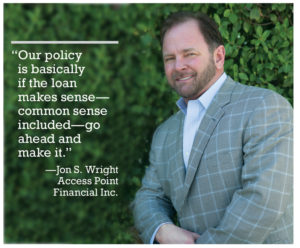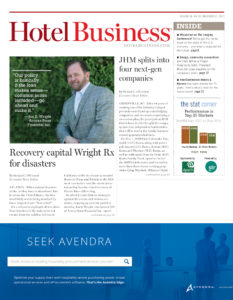ATLANTA—When natural disasters strike, as they have in abundance lately across the United States, the two most likely words being mouthed by those impacted are: “Now what?”
It’s a refrain being heard all too often from hoteliers in the wake of recent events, from the wildfire inferno in California to the hurricane-generated floods in Texas and Florida to the Midwest’s tornadoes and the storm devastation that has the island territory of Puerto Rico still reeling.
 So when it came time to strategize against the events and various scenarios cropping up over the past few months, Jon S. Wright, chairman/CEO of Access Point Financial Inc., opted for a path that could produce the most good in the shortest time: providing recovery capital within 24 hours.
So when it came time to strategize against the events and various scenarios cropping up over the past few months, Jon S. Wright, chairman/CEO of Access Point Financial Inc., opted for a path that could produce the most good in the shortest time: providing recovery capital within 24 hours.
“We look at how we can benefit our clients more than simply being a commodity. I’ve always said, in our business, lending money isn’t so difficult; people know the cost of money. It is a commodity, so it’s not as gray an area as with other suppliers into the industry or in the industry, for that matter,” said Wright.
A veteran of any number of income-crushing, revenue-debilitating crises, from the savings and loan debacle in the late-1980s/1990s that gave rise to the Resolution Trust Corp. to the more-recent Great Recession, Wright has espoused the benefits of “buy now, pay later” programs. Recalling those times, he suggested such an approach—like offering 12 months of no payments to franchisees caught up in the S&L crisis—“really helped people envision where the end of the tunnel was, and allowed them to make a purchasing decision with some level of comfort that 12 months was far enough out that they could acquire goods and services during a slowdown. It was very, very productive for all that were involved.”
The CEO noted he and his team were talking about the company’s philanthropic efforts, such as with the American Red Cross, the American Cancer Society and others, when the question was raised how to help clients during tough times. He sees the current Access Point Financial recovery capital program as almost a rewind back to those S&L times in terms of helping hoteliers. “I’ve kind of surprised myself that we didn’t think of it sooner, but it’s taken on a pretty good bit of popularity,” said Wright.
The executive stressed that the company is committed to helping hoteliers rebuild after damage from recent disasters, particularly hurricanes. With the tagline “Let’s rebuild together,” the recovery capital program offers six months of no payments and 12 months of interest-only payments.
“In the past, and still today, we will provide seasonal-type of payment plans for clients who are in seasonal areas—beaches, ski slopes, whatever the case may be—that they need to build into their debt obligations. We help them with that. So this is really not different,” he said.
“We are delaying the payments altogether,” he continued. “I think it gives a sense of comfort with all that people are worried about in their personal life, which includes their hotel investment as well, and just the day-to-day of things being destroyed or flooded from hurricanes, tornadoes. So we just think in terms of how best to accommodate them to make their lives a little simpler than what it would be otherwise… It gives them the ability to go ahead and order or pay for goods and services that the hotel certainly needs to renovate and re-establish their presence in the market. They also have their insurance claims coming. We’re just a bridge.”

Access Point Financial’s recovery capital program aims to help hotels that are hurt by natural disasters.
Wright said the company has fielded requests from the Houston area, which was slammed by Hurricane Harvey in late August, as well as several beach locations. Thus far, no offshore requests have come to Access Point Financial; however, the CEO noted, “We will, and have, provided that offshore type of financing in the past.”
Creditworthiness is among the criteria the company, which issues some 250 loans a year, is taking into consideration for those seeking financing via the recovery capital program, although Wright said there’s flexibility.
“We can manage around issues that a client can explain to us in simple terms; we’re flexible in that regard,” he said.
In terms of collateral—or the lack thereof given destroyed properties—Access Point Financial is typically securing the FF&E being replaced.
“And then the insurance company and/or senior lender would take control of that lien once we were paid off,” said the CEO. “It really looks like a bridge program. I don’t think it’s that prevalent out there because a lender is not going to make as much money off of it if you’re only into the loan for six to 12 months. Lenders want to be typically more than three, four years into a loan term before they can make enough capital from that loan to make it worth their while to originate it.”
As for the size of the loans, Wright said he’s seeing a range anywhere between $50,000 to $15 million. “Our loans in ‘normal days’ are typically $250,000 to $25 million, and that’s new-construction included in that $25 million,” he added.
Interest rates mirror those on typical transactions and are in the 7-9% range, trailing down if Access Point Financial has the senior debt on the entire asset versus a secondary sliver in the capital stack, which is typically the case.
Right now, there’s no particular pattern of segment type seeking the financing, although Wright observed there haven’t been many requests from full-service resorts. “Primarily, the dollars we deploy are found to be most viable in select-service assets, tertiary markets. But again, we’ll see some urban requests that come in from the inner city and from the MSAs that we sometimes don’t see because of the nature of the principal behavior of those types of assets. The banks want to make those loans, and typically, you have a senior loan in place already, so they would be the likely candidates to make any type of a bridge loan until some insurance proceeds were consummated,” he said.
Overall, said Wright, the recovery capital program is in line with company policy. “And our policy is basically if the loan makes sense—common sense included—go ahead and make it. We would certainly entertain this type of a loan for anyone calling up and explaining a situation they wanted us to help manage,” he said.
The executive expects the program to close on $50 million to $75 million by year’s end. HB

